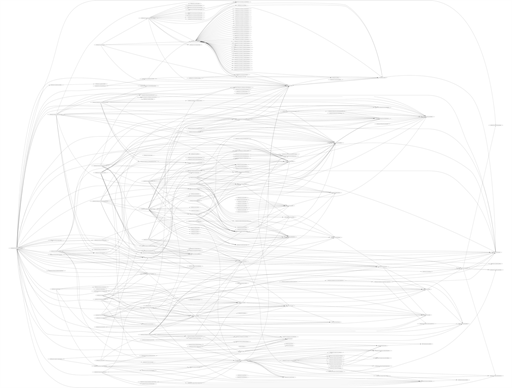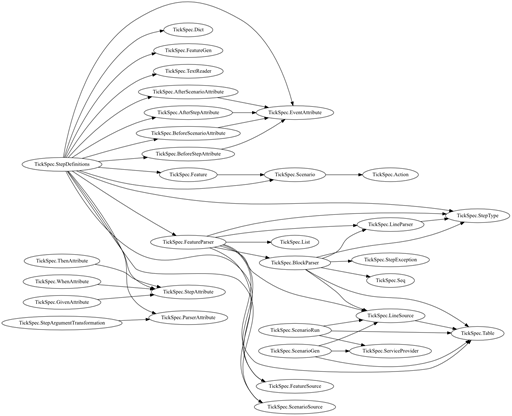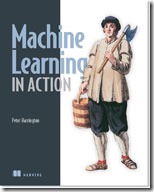Scott Wlaschin has just posted a really interesting series on Dependency cycles over on the F# for fun and profit site. The last post shows cycles and modularity in the wild comparing open source C# and F# projects including SpecFlow and TickSpec which have almost identical functionality,.
Here’s the dependency diagram for SpecFlow (C#):

and for TickSpec (F#):

They both have very similar functionality and in fact TickSpec implements it’s own parser too. Read Scott’s article to better understand why such large differences exist between C# and F# projects.
Last night the F#unctional Londoners Meetup put on a Hands On Machine Learning session at Skills Matter in London. It was a really well attended event, so much so that we had to put a cap on the number of attendees when we reached 70 registrations. The material was recycled from a well received session by Mathias Brandewinder at the San Francisco Bay Area F# User Group in May.
I find F# a very good fit for Machine Learning, in fact my first use of F# was for the player matchmaking on Halo 3.
The goal of the session was to create a digit recognizer using Kaggle’s competition data set.
The first part of the session was to parse and transform the provided CSV files:
let path = @"c:\Digits\digitssample.csv"
let lines = File.ReadAllLines(path)
lines |> Array.map (fun line -> line.Split(','))
Then to implement the K-nearest neighbours algorithm to classify digits. KNN is the first algorithm explained in Manning’s Machine Learning in Action book.

We used a guided script in the session that takes you through the problem in small manageable tasks, each one introducing the necessary F# language contructs required, which you could work through at home too.
Thanks for all the kind feedback:
-
 Finn Neuik
Finn Neuik @finnneuik
great evening at #fsharp UG courtesy of #kaggle, @skillsmatter and @ptrelford : I do like a bit of machine learning!
-
 James Crowley
James Crowley @JamesCrowley
Great evening learning some F# and machine learning with the help of @ptrelford @skillsmatter - thanks Phil!
-
 Andy Brackley
Andy Brackley @andybrackley
Thanks @ptrelford for a great session on machine learning in f#. Excellent content and presentation
-
 Chris Austin
Chris Austin @cja117
@ptrelford thanks for a great #fsharp workshop at #SkillsMatter in London.
If you’re interested in learning more check out:the Machine Learning with F# page on the F# Software Foundation site which includes plenty more tutorials.
This week I added a simple tremolo effect to my mini-keyboard project Monokeys. Tremolo is a trembling effect, and sometimes seen in Low Frequency Oscillators.
I found an example of Coding some Tremolo and wrote the formula as an F# function:
let tremolo freq depth i = (1.0 - depth) + depth * (sineWave freq i) ** 2.0
Then I added sliders for the frequency and depth to compose the shape of a sound:
let tremolo i = tremolo tremoloFreq.Value tremoloDepth.Value i
let shape i = sineWave freq i * fadeOut i * tremolo i
Full source code is available on BitBucket: https://bitbucket.org/ptrelford/monokeys